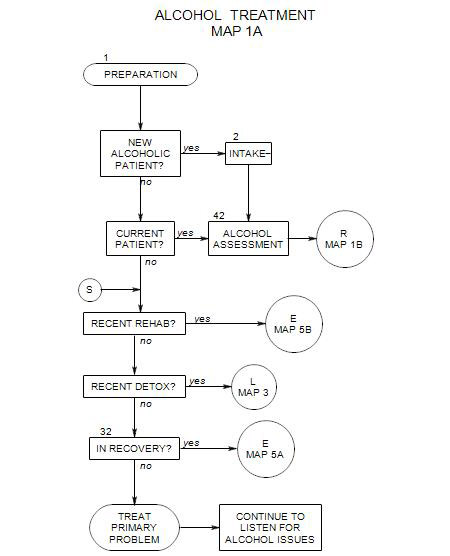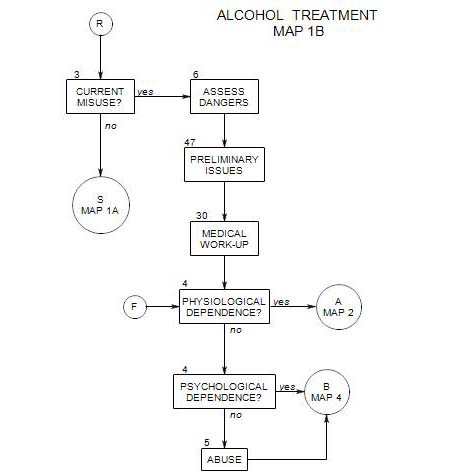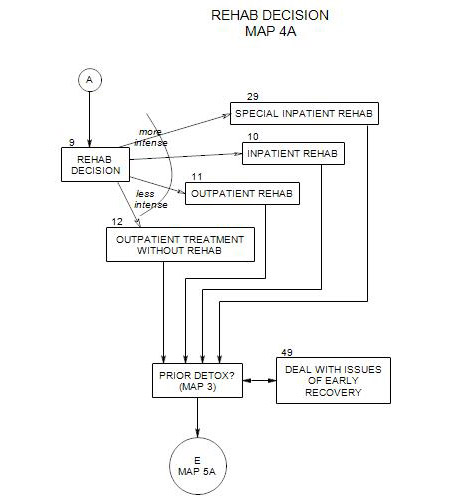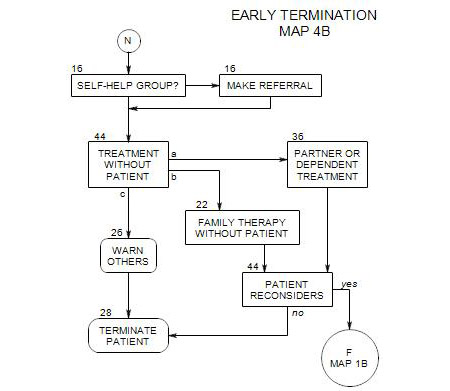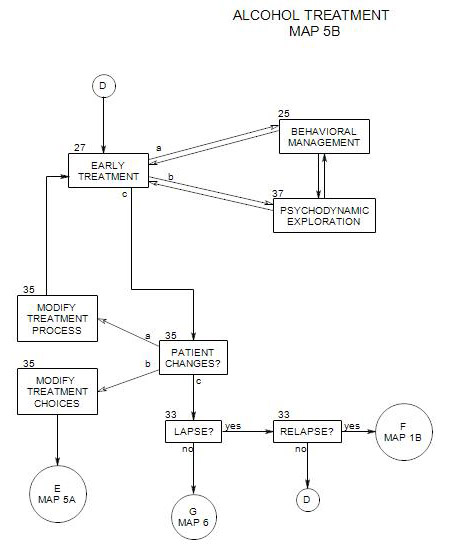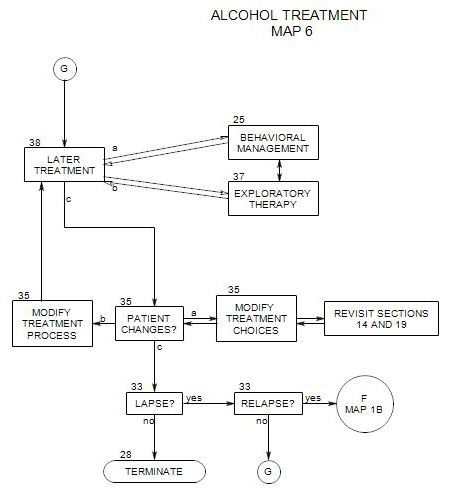18. GROUP THERAPY OR COUNSELING
- This section follows Section 14 [Primary Form of Outpatient Treatment] or Section 19 [Adjunctive Care Decision] on Map 4 for some patients.
Group therapy is often a reasonable option for treating alcoholic patients, and it is generally the preferred treatment modality for hospitals and clinics. However, it tends to be less often used in outpatient settings for a variety of reasons, including the need for special training of the group leader, difficulty keeping a group full enough to pay the costs of running it, problems of adding or losing members of an established group, and competition with self help groups such as AA, which are typically free.
Look for groups in more populated areas or in outpatient clinics. In some areas, there may be none available. Check with the group therapist or leader before making a referral, to see if it is appropriate for your patient.
18a. Types of Groups Available
As in any referral process, it is generally good to know what kinds of groups are available before making the referral. If possible, it might benefit some patients to be in a group where the other members are of the same sex or sexual orientation, or have similar psychiatric diagnoses. This could lead to a greater sense of safety, a more intense experience, a greater willingness to participate, and increased effectiveness of group pressures. However, if it is difficult to keep a group full of participants, then it is even harder to start and maintain a group that is homogeneous along any dimension.
THERAPEUTIC FOCUS
A given group could be directed primarily to treatment of alcohol issues, of drugs and alcohol, or to other psychotherapy issues. Group process can focus on varying combinations of supporting each other, confronting one another, experimenting together in forms of interaction, and so on.
LEADERSHIP
The therapist may be directive and controlling or laid-back and emphasizing peer interactions. The leader may emphasize intellectual understanding, emotional expression, or physical actions.
THEORETICAL PERSPECTIVE
Here the main point would be that the perspective of the group is compatible both with the patient’s issues and perspective, and with the kind of treatment approach being used in individual therapy.
18b. Purpose of Group Therapy
Group therapy may be either a primary form of treatment or adjunctive to individual therapy. When it is the primary treatment modality, adjunctive individual treatment can be used, among other things, to process the impact of the group on the patient and the implications for the patient’s life.
18c. Groups and Phase of Recovery
Groups for treatment of alcoholism may be limited to patients in approximately the same phase of recovery, as in the following example scheme:
Phase I: This first group is directed to people right after detoxification, and may last from 10 days to 3 months. Participants work on acceptance of alcoholism as dysfunctional, compulsive behavior and awareness of the destructiveness that results from it. Patients may be there under duress. Group process and confrontation are used to break through the patient’s denial.
A lot of anger tends to be released in the group, because patients can no longer use alcohol to self-medicate. This can lead to confrontations among group members, as they critically examine and challenge each other. Identifying incentives to sobriety (eg: you won’t get hit by a car as you cross the street) and relapse prevention. Regular attendance at self-help groups is encouraged.
Phase II: Here the focus is on early sobriety. Participants discuss a variety of coping strategies, including
- Identifying triggers for drinking
- Identifying incentives to sobriety (eg: You’ll be permitted to complete your rehab and your boss will hold your job for you.).
- Relapse prevention.
- Regular attendance at self-help groups.
- Acknowledging the possibility of other replacement self destructive behaviors and ways to cope with them.
Phase III: is focused on staying sober. Techniques may include
- meditation/relaxation training
- body awareness
- imaging
- identifying incentives to sobriety (eg: you won’t lose your job)
- recognizing possible positive outcomes and effects of staying sober, such as increased interest in food
- relapse prevention
- regular attendance at self-help groups
Phase IV: is focused on family issues, such as
- family of origin issues
- psychological issues
- parenting
- anger
- enriching and enhancing interpersonal relationships.
- identifying incentives to sobriety (eg: your wife won’t ask you to move out).
- relapse prevention
- regular attendance at self-help groups.
In this plan, the Phase IV group could easily be a psychotherapy group, operating with a recovery perspective.
Whether groups are used and members selected using this plan or another, it is good to try to match a patient with a corresponding group when making an initial referral. It is also important to be aware of the group’s phase and focus when dealing with your patient in individual treatment. Many issues may come up in the group that can be processed in a complementary way in individual therapy.
Recovering alcoholics tend to react strongly to group pressures, especially early in recovery. You need to be careful about challenging group conclusions, even about your patient, and even when you think the group is wrong. However, if you maintain regular contact with the group therapist, you can generally coordinate the two treatment modalities for the benefit of your patient.
18d. Who Should Run Groups
There may be a benefit to having the same therapist for individual and group therapy, because the therapist can observe the patient interact with others and process the meaning of, and implications of those interactions privately. The therapist can also use private information to design particular interactions among group members.
